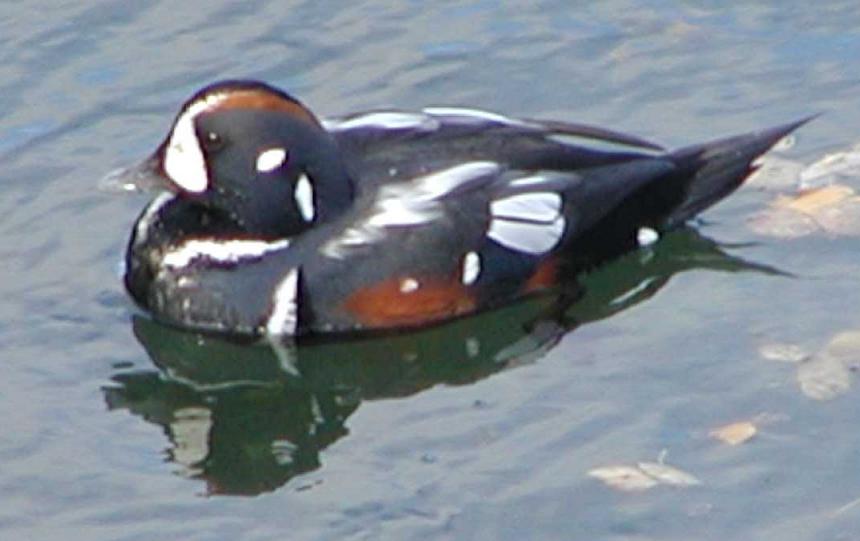- Harlequin Duck
Taxobox
name = Harlequin Duck
status = LC | status_system = IUCN3.1

image_width = 200px
image_caption = Adult drake
regnum =Animal ia
phylum = Chordata
classis =Aves
ordo =Anseriformes
familia =Anatidae
genus = "Histrionicus"
genus_authority = Lesson, 1828
species = "H. histrionicus"
synonyms ="Ocyplonessa"
binomial = "Histrionicus histrionicus"
binomial_authority = (Linnaeus,1758 )The Harlequin Duck, "Histrionicus histrionicus", is a small sea duck. In
North America it is also known as Lords and ladies. Other names include painted duck, totem pole duck, rock duck, glacier duck, mountain duck, white-eyed diver, squeaker and blue streak.Adult males are slate blue with chestnut sides and white markings including a white crescent at the base of the bill. Adult females are less colourful, with brownish-grey plumage and a white patch on the head around the eye. Both adults have a white ear patch.
Their breeding habitat is cold fast moving streams in north-western and north-eastern
North America ,Greenland ,Iceland and westernRussia . The nest is usually located in a well-concealed location on the ground near a stream. They are usually found near pounding surf and white water.They are short distance migrants and most winter near rocky shorelines on the Atlantic and Pacific coasts. They are very rare vagrants to western
Europe .These
bird s feed by swimming under water or diving. They also dabble. They eatmollusc s,crustacean s andinsects . Harlequins have smooth, densely packed feathers that trap a lot of air within them. This is vital for insulating such small bodies against the chilly waters they ply. It also makes them exceptionally buoyant, making them bounce like corks after dives.The eastern North American population is declining and is considered endangered. Possible causes include loss of habitat due to
hydroelectric projects and loss of life due tooil spill s near coastal areas.Today, this is the only species of its
genus . Two prehistoric harlequin ducks were described fromfossil s, although both were initially placed in a distinct genus: "Histrionicus shotwelli" is known from Middle to LateMiocene deposits ofOregon ,USA and was considered to form a distinctmonotypic genus, "Ocyplonessa". "Histrionicus ceruttii" which lived inCalifornia during the LatePliocene was at first taken to be a species of the related genus "Melanitta ".The Harlequin Duck takes its name from
Arlecchino ,Harlequin in French, a colourfully dressed character inCommedia dell'arte . The species name comes from theLatin word "histrio", "actor".References
* Database entry includes justification for why this species is of least concern
* National Geographic, November 1993 "Bird of White Waters", by Douglas H. ChadwickExternal links
* [http://www.birds.cornell.edu/AllAboutBirds/BirdGuide/Harlequin_Duck.html Cornell Lab of Ornithology - Harlequin Duck]
* [http://www.mbr-pwrc.usgs.gov/id/framlst/i1550id.html USGS Patuxent Bird Identification InfoCenter - Harlequin Duck]
* [http://www.sdakotabirds.com/species/harlequin_duck_info.htm South Dakota Birds and Birding - Harlequin Duck Information and Photos]
* [http://www.enature.com/fieldguides/detail.asp?recnum=BD0416 eNature.com - Harlequin Duck]
Wikimedia Foundation. 2010.
